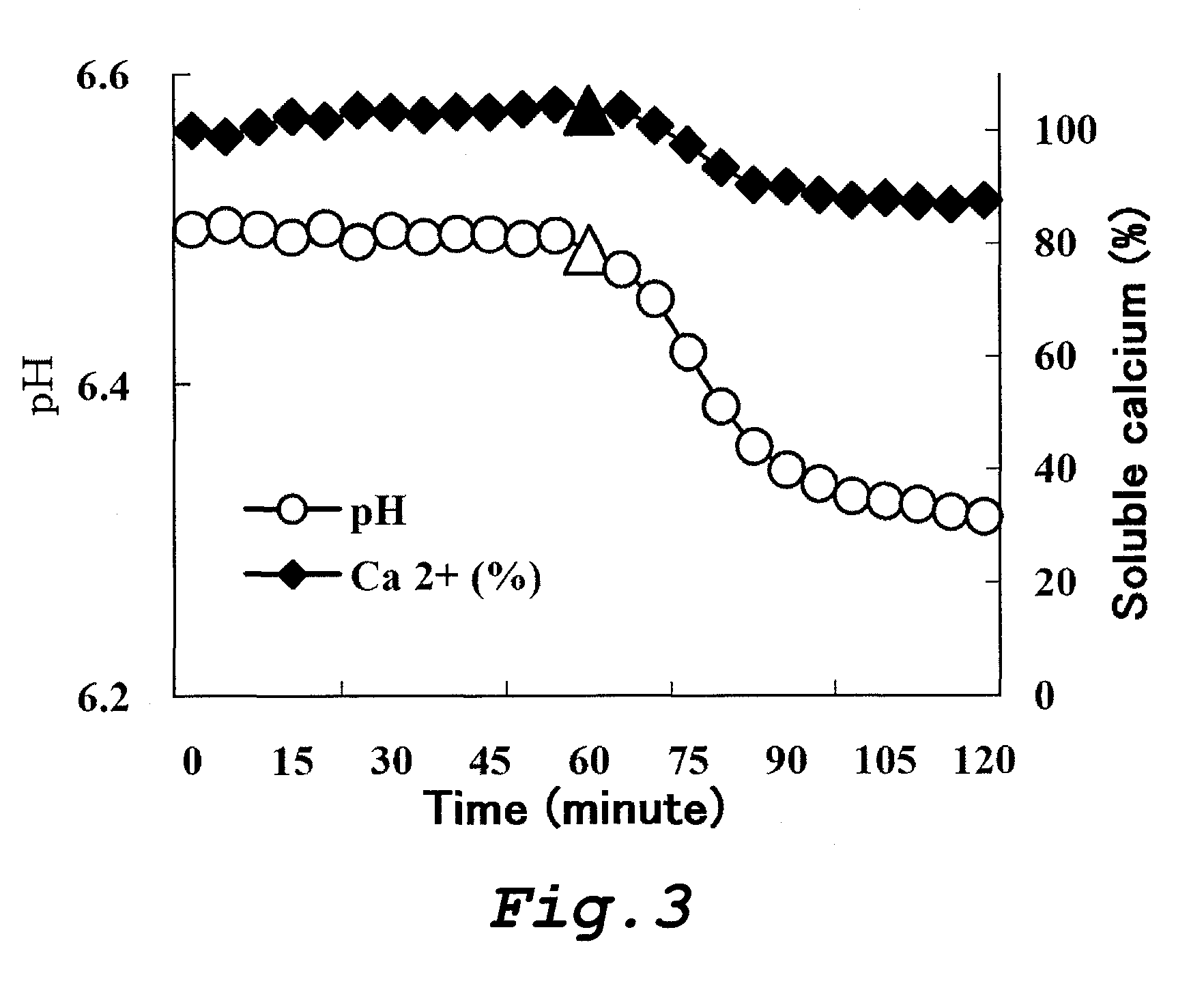Food and composition each comprising phosphorylated saccharide, polyphenol and fluoride
a technology of phosphorylated saccharide and food, applied in the field of cariostatic oral composition and food, can solve the problems of dental caries formation, inability to fill defective parts, and inability to natural restoration, and achieve the effects of reducing polyphenol content, excellent remineralization effect, and effective utilization
- Summary
- Abstract
- Description
- Claims
- Application Information
AI Technical Summary
Benefits of technology
Problems solved by technology
Method used
Image
Examples
examples
1. Phosphorylated Saccharide Calcium Salt Used
[0373]A phosphorylated saccharide calcium (POs-Ca) used in the following Tests, Examples and Test Examples refers to a phosphorylated saccharide calcium prepared from potato starch using calcium chloride in place of sodium chloride by the procedure described in Example 1 of Japanese Laid-open Patent Publication No. 8-104696. That is, it is a mixture of phosphorylated saccharide calcium in which 1 to 2 phosphate groups are bonded to an oligosaccharide composed of α-1,4-bonded 2 to 8 glucose in the molecule and calcium is bonded to each of the phosphorylated saccharides. The phosphorylated saccharide calcium is a mixture of those in which one phosphate group is bonded to an oligosaccharide composed of 3, 4 or 5 glucose in the molecule and calcium is bonded to this phosphate group, and those in which 2 phosphate groups are bonded to an oligosaccharide composed of 5, 6, 7 or 8 glucose in the molecule and calcium is bonded to this phosphate g...
example 1
Confirmation of Effect by Concentration of Fluoride
[0395]In the present Example, the concentration of a tea-derived fluoride was examined.
[0396]Artificial saliva with each of the compositions of acid resistance tests A to C in Table 2 shown below was prepared. In the present Example, this artificial saliva was used as the remineralization solution. In this case, calcium or phosphoric acid was added and adjusted using a small amount of 1N hydrochloric acid solution and HEPES solution which is a buffer solution. Subsequently, after the pH was neutralized by adding a 1N potassium hydroxide solution, a demineralization treatment was carried out at 36±0.5° C. at pH 6.5±0.02 in the same manner as in the aforementioned “3. Formation of Subsurface Demineralized Lesion”. At a point in time of the demineralization treatment, one forth (¼) of the enamel surface was covered with a nail varnish and the portion of ¾ of the surface had been demineralized. Furthermore, bovine tooth pieces, in which...
examples 2-1 to 2-3
and Comparative Examples 2-1 to 2-3
Confirmation of Remineralization Effect at Various Fluoride Concentrations
(i) Examination of the Influence of Fluoride Concentration
[0411]The effect of using a low-concentration fluoride and POs-Ca contained in a tea extract in combination was compared with the effect of using a low-concentration fluoride contained in a tea extract and CaCl2 in combination. Furthermore, the concentration of a tea extract added, at which the remineralization effect of POs-Ca was not inhibited and also acid resistance of fluoride was obtained, was examined.
[0412]In the present Examples and Comparative Examples, bovine toothpieces subjected to a demineralization treatment in the same manner as in “3. Formation of Subsurface Demineralized Lesion” were used. These bovine tooth pieces were bovine tooth pieces in which the portion of ¼ of the enamel surface was a healthy portion and covered with a nail varnish, and also the proton of ¾ of the surface was demineralized and...
PUM
| Property | Measurement | Unit |
|---|---|---|
| Fraction | aaaaa | aaaaa |
| Fraction | aaaaa | aaaaa |
| Fraction | aaaaa | aaaaa |
Abstract
Description
Claims
Application Information
 Login to View More
Login to View More - R&D
- Intellectual Property
- Life Sciences
- Materials
- Tech Scout
- Unparalleled Data Quality
- Higher Quality Content
- 60% Fewer Hallucinations
Browse by: Latest US Patents, China's latest patents, Technical Efficacy Thesaurus, Application Domain, Technology Topic, Popular Technical Reports.
© 2025 PatSnap. All rights reserved.Legal|Privacy policy|Modern Slavery Act Transparency Statement|Sitemap|About US| Contact US: help@patsnap.com



